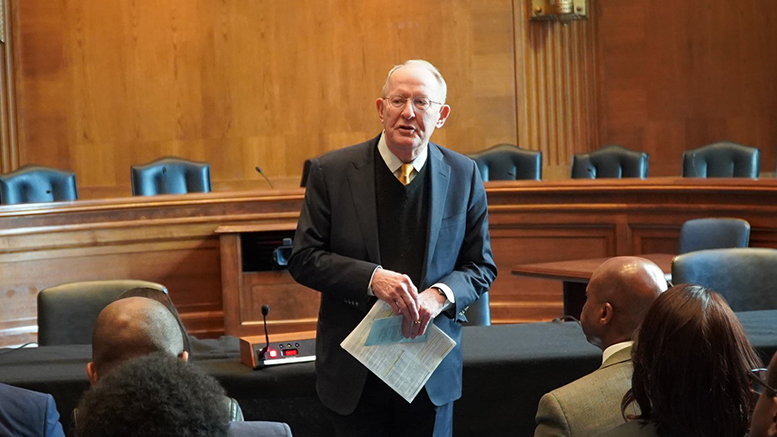The Senate education committee on Tuesday started a new round of hearings to reauthorize the Higher Education Act with something almost all Republicans and Democrats could agree on: Simplify the federal student aid application as well as the verification process.
Sen. Lamar Alexander (R-Tennessee), chair of the Senate Labor, Health, Education and Pensions Committee, opened the hearing with a favorite prop of his: unfolding a copy of the 108-question Free Application for Federal Student Aid (FAFSA).
The length is an impediment to enrolling in college, he said, citing that Southwest Tennessee Community College officials say the college loses 1,500 students each semester because the FAFSA is too complicated to complete.
“The vast majority of questions are unnecessary,” said Alexander, who last month announced his outline to reauthorize HEA, which includes simplifying FAFSA, offering only two federal student loan repayment options and creating a new accountability system that extends “gainful employment” rules to all public and private higher education institutions.
Democrats on the committee agreed that simplifying the FAFSA and improving the verification process is important. But they want broader, comprehensive reform on HEA rather than a piecemeal approach.
“I believe we must also commit to strengthening and expanding our federal financial aid programs in order to help students in need afford the true costs of college and earn a higher education without taking on suffocating debt,” said Sen. Tammy Baldwin (D-Wisconsin), who also noted two key points in HEA reauthorization for Democrats: improving institutional accountability, and addressing discrimination and safety on colleges campus.
Tripping points
One sticking point on the FAFSA is the inquiry about expected family contribution, Alexander said. The problem is that the form has some 50 questions dealing with that.
The verification process — which is designed to ensure information provided to the U.S. Education on the FAFSA matches with what was submitted to the IRS — is even more difficult, the chairman said, noting he wants to “dramatically decrease the number of students flagged for verification.”
In Washington state, the FAFSA application and verification process are especially difficult for members of Native American tribes, foster youths and students who have trouble getting W-2 tax forms from previous employers, said Michael Meotti, executive director of the Washington Student Achievement Council, who testified at the hearing.
Kristina Scott, executive director of Alabama Possible, offered one example of how the FAFSA rules trip up potential students: A young woman who was raised by her grandparents, although they were not her legal guardians, was unable to complete the form because her father refused to provide his tax information. If Alabama Possible hadn’t found a local foundation to pay her tuition, she would not have gone to college.
“Students who want to go college should not be negatively impacted by their family situation,” Scott said.
As an alternative, several witnesses at the hearing recommended that students who qualify for free or reduced-priced school lunches or SNAP (the Supplemental Nutrition Assistance Program) should be automatically eligible for student aid without having to produce duplicate financial information.
Also, the language on the form needs to be simplified, as students don’t understand terms like “emancipated minor,” Scott said. She also suggested students shouldn’t have to renew their FAFSA every year, and should only have to fill it once if they stay at a college, and again only if they transfer.
Verification too complex
The witnesses also agreed that fewer applicants would be subject to the verification process if the IRS and the Education Department shared financial information about college applicants, which is a proposal Alexander has floated.
“Many students and counselors tell me the verification process is worse than filling out the FAFSA,” the senator said.
Lower-income students are disproportionately selected for verification, said Michele Scott Taylor, chief program officer at College Now Cleveland. She noted 25 percent of applicants tagged for verification end up not enrolling in college.
“Verification targets individuals who need aid the most,” added Mark Wiederspan, executive research officer at Iowa Student Aid.
The complexity of verification is especially challenging for institutions with a high percentage of Pell Grant recipients, such as community colleges, he added.
The process to select applicants for verification should be more transparent, Wiederspan said, adding that he would like to see the 30 percent verification cap for institutions reinstated.

